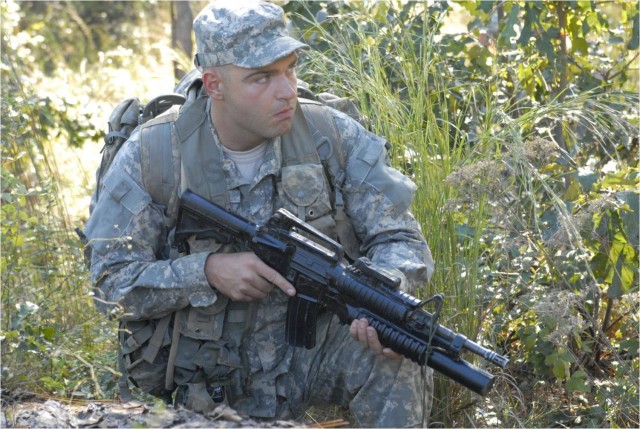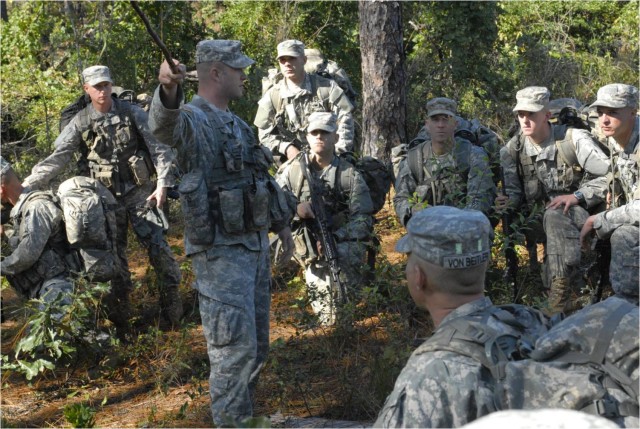FORT BENNING, Ga. - The Warrior Training Center's footprint has grown considerably across the Army since its creation in 2003.
Six years ago, the organization offered one course to about 200 Soldiers. In fiscal 2009, the curriculum had expanded to six classes as the center trained 6,479 service members on site and through 14 mobile training teams, which included trips to Puerto Rico and Guam.
And the Warrior Training Center isn't just a haven for Reserve and Guard forces. Although fully funded by the Army National Guard, up to 40 percent of its students are on active duty, said Tom Siter, the unit's executive officer.
The program's six courses, which range from five to 17 days in duration, are Pre-Ranger (958 students last year), Combatives levels 1 and 2 (238), Air Assault (4,913), Pathfinder (209), Pre-Bradley Master Gunner (71) and Bradley Crew Evaluator (90). About 370 troops can reside in the compound's barracks.
"We've taken a big leap in recent years," he said. "There are 114 cadre assigned here right now, and we're getting bigger."
In 2003, the center shared a facility with the Maneuver Battle Lab. Today, it's spread over 45 acres under constant development, with plans to stand up a fourth company to accommodate the Guard's Armor community, Siter said. About $8 million is being spent on construction in fiscal years 2009 and 2010.
Projects include an Armor training facility, one-mile paved running track with lights, student long-term parking and Air Assault graduation parking lots, new battalion headquarters, physical fitness center, and a headquarters and headquarters company and battalion aid station.
As Armor elements from Fort Knox, Ky., are relocated to Fort Benning, the Warrior Training Center will add a Pre-Armor Master Gunner Course, Armor Crew Evaluator Course, and simulators and fieldings for the Guard's Armor wing, Siter said.
MAJ Jamison Kirby, operations officer, said the post is home to the Army's only Warrior Training Center and a primary focus is preparing deploying units for rotations in Afghanistan, Iraq and the Balkans. But courses have the dual benefit of fortifying state missions tied to homeland security, disaster relief and other domestic emergencies.
"They get extra skills here that not every Soldier is going to have coming out of basic training," Kirby said. "They don't fit into their regular job description. We try to incorporate them all under this one umbrella at the WTC. It's all functional training ... Soldiers can use it in war, but they can also move equipment for people back home who might have no road access in a flood."
Kirby said participation in Air Assault courses nearly doubled last year as the WTC conducted a dozen resident classes.
"The National Guard used it as a recruiting tool - instead of giving out bonuses," he said. "The Guard didn't really have a program like that before. We mostly bring it to them through our MTTs ... It's much easier for us to go out to the states rather than put 25 to 30 Soldiers on a plane here. That reduces travel, TDY and per diem costs."
The Air Assault course was launched in 2004 while Pathfinder training began two years ago, said 1SG Douglas Conaway, B Company's first sergeant. Air Assault stresses students physically through sling load, medical evacuation, rappelling and lifting phases. The Pathfinder class has greater mental demands with emphasis on calculations and air-traffic control.
"Both courses are critical within the air-mobility portion of the war on terrorism," Conaway said. "Moving equipment, personnel and supplies through the air is a big part of the mission."
Vehicle and firearms simulators play a major instructional role for C Company, which leads the Pre-Bradley Master Gunner and Bradley Crew Evaluator courses, said CPT Matt Giblin, the unit's commander. Both started at the WTC in 2006.
About 30 Marines have attended the Pre-Bradley Master Gunner program, which Giblin called the "go-to class" for Soldiers entering the Bradley Master Gunner Course. He said graduates face a 96 percent chance of making it through the 11-week course taught by 1st Battalion, 29th Infantry Regiment, at the Collins Training Center.
"It's one of the most mentally challenging courses in the Army - the graduation rate is as low as 49 percent," Giblin said. "By coming to our course, you've increased your chances of being successful at that course by 30 to 40 percent."
WTC officials expect an increase in combatives classes over the next year after Fort Benning's U.S. Army Combatives School stopped Level 1 and 2 training, Kirby said. A Company teaches Combatives and Pre-Ranger.
He said the Pre-Ranger course, which accepts students from all service branches, is aimed at cutting down on the actual school's attrition rate.
"Assessments are done to make sure they can pass that first week," Kirby said. "For 80 percent of the guys who fail Ranger School, it happens in the first week."
SFC David Brigman, the battalion operations manager for resources and air and a former Pre-Ranger instructor at the WTC, said many students apply added stress to themselves by fretting over factors beyond their control. Harsh weather conditions, lack of sleep and chow, and knowledge deprivation will always be part of the Ranger School landscape, he said.
"You can't prepare yourself for the 'suck' factor, but you can prepare your body and mind for how you're going to deal with it," Brigman said. "When they get down there after Pre-Ranger, it's not a surprise to them."
Kirby said the Warrior Training Center fills gaps in warfighter development by providing NCOs and officers with skill sets outside the Army's traditional training venues.
"These courses provide things they won't receive elsewhere," he said. "We're putting those other capabilities they need to be successful on the battlefield into their rucksacks."




Social Sharing